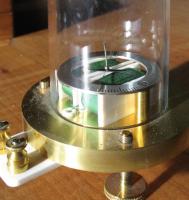| www.tmatlantic.com
Test & Soldering Equipment On-line Store |
|
D.E.V.I.C.E. (Wiki)Calculators Services |
|||||
Filter by first letter
|
First astatic galvanometer
On May 13, 1825, Leopoldo Nobili demonstrated the first astatic galvanometer, a historical instrument that measures electric current. It consists of two magnetized needles, suspended from their centers by a long thin fiber which can turn freely. One needle is inside a coil of wire. When electric current passes through the coil, its magnetic field causes the needle to turn from its equilibrium position perpendicular to the coil to be parallel to the coil's axis. The second needle (visible), located above the coil and magnetized in the opposite direction, serves to cancel out the effect of the Earth's magnetic field (that's what the "astatic" means), and also serve as a pointer to indicate the magnitude of the current. Citing: Wikipedia.org |
Site mapPrivacy policyTerms of Use & Store PoliciesHow to BuyShippingPayment




|

























